Must Know High School Biology - Kellie Ploeger Cox 2019
PART THREE Genetics
Meiosis
MUST ![]() KNOW
KNOW
![]() In meiosis, after the chromosomes are duplicated, the cell will undergo two rounds of cell division.
In meiosis, after the chromosomes are duplicated, the cell will undergo two rounds of cell division.
![]() The first division (Meiosis I) separates the homologous chromosomes into two separate cells.
The first division (Meiosis I) separates the homologous chromosomes into two separate cells.
![]() The second division (Meiosis II) separates the genetically idential sister chromatids into a total of four separate cells.
The second division (Meiosis II) separates the genetically idential sister chromatids into a total of four separate cells.
![]() After Meiosis I (and the homologous chromosomes are separated), the resulting cells are haploid.
After Meiosis I (and the homologous chromosomes are separated), the resulting cells are haploid.
![]() The goal of meiosis is to produce cells that are different from the starting cell.
The goal of meiosis is to produce cells that are different from the starting cell.
As we just learned, mitosis is a type of cellular division that creates two genetically identical daughter cells. This is important, because if a single fertilized egg is going to undergo countless rounds of cell division to create the final multicellular life form, it better make sure every cell has the same set of chromosomes!
![]()
This is an important concept that we should pause to reconsider. A multicellular organism is made of trillions of cells, each with the same DNA (thanks to mitosis). But what about the fact that a multicellular organism isn’t a huge blob of the same types of cells? We have muscle cells, skin cells, cells that produce hair, and cells that secrete insulin. This wide variety of cells still contain the same DNA, the same chromosomes, the same genes. The difference, however, is what genes they choose to express. A pancreatic cell (alpha cell, specifically) will focus in on that insulin gene and create lots of insulin protein; your skin cell, however, will happily ignore that insulin gene. This is the phenomenon of gene expression (back from Chapter 11).
Now, there is a very important exception to this rule of “if you make cells for a multicellular organism, they better all have the same genes.” The gametes—egg and sperm—are each unique creations with a different combination of chromosomes. Sure, all the eggs in a female (or sperm in a male) are created using the same source cell, but the process of meiosis ensures that each resulting gamete cell is different in two ways:
1. Meiosis creates cells with half the DNA of the parent cell (specifically, one set of chromosomes instead of the usual two sets).
2. Meiosis shuffles these two sets of chromosomes like a deck of cards and then randomly deals them out into the gametes.
It is a must know to understand that meiosis intends to create cells different from one another (unlike mitosis, which aims to create identical cells). Let’s talk about these differences in more detail.
Meiosis Creates Cells with Half the DNA (only one set of chromosomes)
Let’s start with you, shall we? A long time ago, a man and a woman made a baby, and that baby was you. You are a genetic combination of those two people: the man sent over a set of chromosomes in a sperm cell, and the woman sent over another set of chromosomes in an egg cell. This term set is significant. Humans have a total of 46 chromosomes, but more specifically, there are two sets of 23:
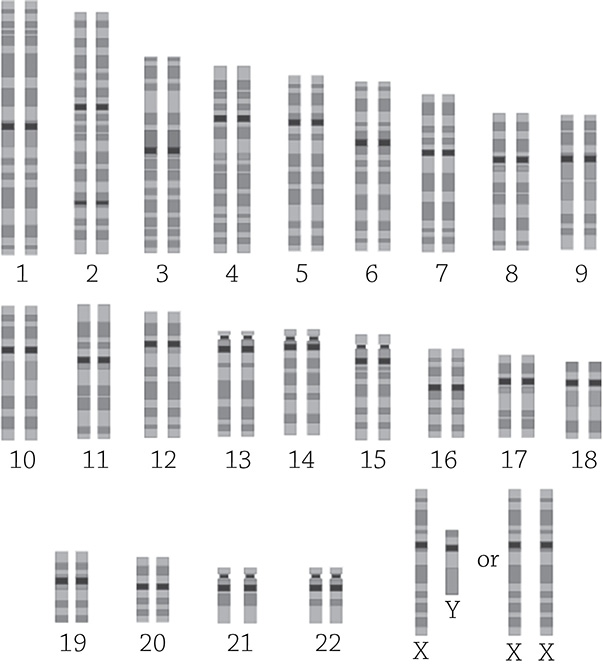
Karyotype of a human male
Author: Mikael Häggström. https://commons.wikimedia.org/wiki/File:Human_karyotype.svg
A karyotype is a visual layout of all the pairs of chromosomes in a critter. The previous figure on page 205 is an example of a human karyotype. Look at chromosome number 1 … there are, in fact, two of them. Where did you get two number 1 chromosomes? One came from your mom’s egg and one came from your dad’s sperm! You are literally the genetic composition of your mother and your father. These two chromosomes contain the same genes (about 2,000 of them), and are the same size and shape. They are not, however, genetically identical (one came from your mother and one came from your father … and they are most certainly not genetically identical). These matching chromosomes are called homologous chromosomes. If you take one of each homologous pair, you create a single set of chromosomes, numbers 1—22. The final “pair” of chromosomes are the sex chromosomes—the X and the Y chromosome—and they are not considered homologous because they do NOT contain the same genes. If you have one X and one Y chromosome, you are male; if you have two X chromosomes, you are female.
![]()
Chromosomes are assigned numbers based on their size. The biggest chromosome is #1, and the smallest chromosome is #22.
In summary: a single set of chromosomes consists of chromosome numbers 1 through 22, plus either an X chromosome or a Y chromosome. The shorthand way to indicate a cell contains a single set is “n,” also called haploid; the gametes’ chromosome count is n = 23. When a sperm fertilizes an egg, the two sets combine into 2n = 46. Another term for having two sets of chromosomes is diploid. By far, most of the cells in your body (besides the egg or sperm) have two sets of chromosomes, and are designated 2n. Furthermore, the majority of cell division occurring in your body is through mitosis, by which a diploid cell creates more diploid cells. The ONLY cells in the human body that undergo meiosis are the special cells in the ovaries and testes that are responsible for making eggs and sperm. Spermatocyte cells in the testes undergo meiosis to create sperm, and oocyte cells in the ovaries undergo meiosis to create eggs.
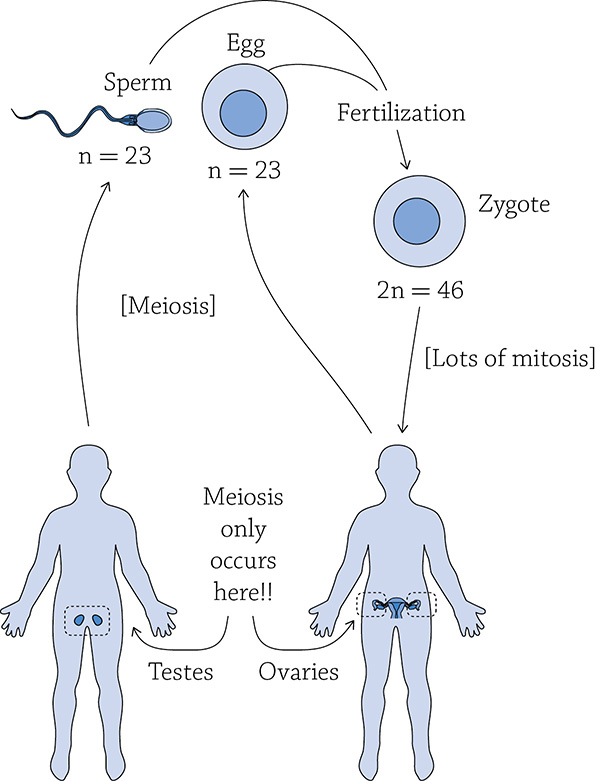
The way meiosis manages to create haploid cells with only one full set of chromosomes is quite clever, and involves two division steps instead of one (as in mitosis). I will show you how it’s done, starting with the same cell we used in the mitosis example.
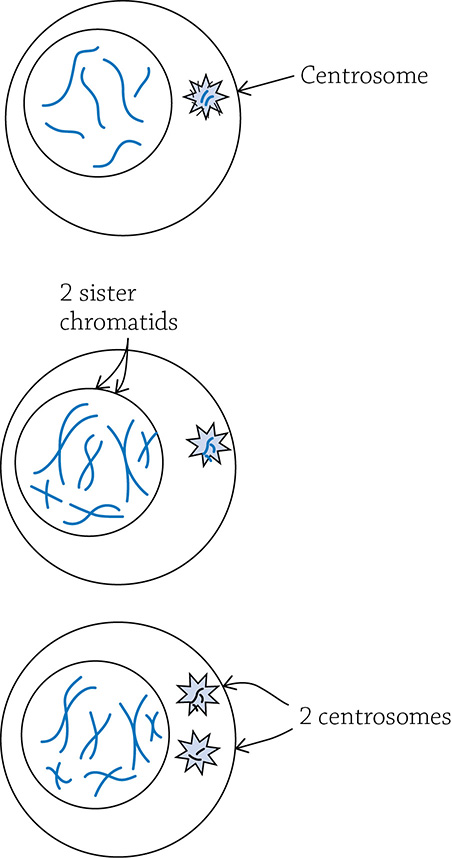
As in mitosis, the cell must first replicate its DNA, creating chromosomes consisting of two genetically identical sister chromatids. If the cell divides by mitosis, it would then split apart the two sister chromatids and be done with it. Meiosis, however, first divides up the homologous chromosome, and THEN it divides up the sister chromatids (just like mitosis).
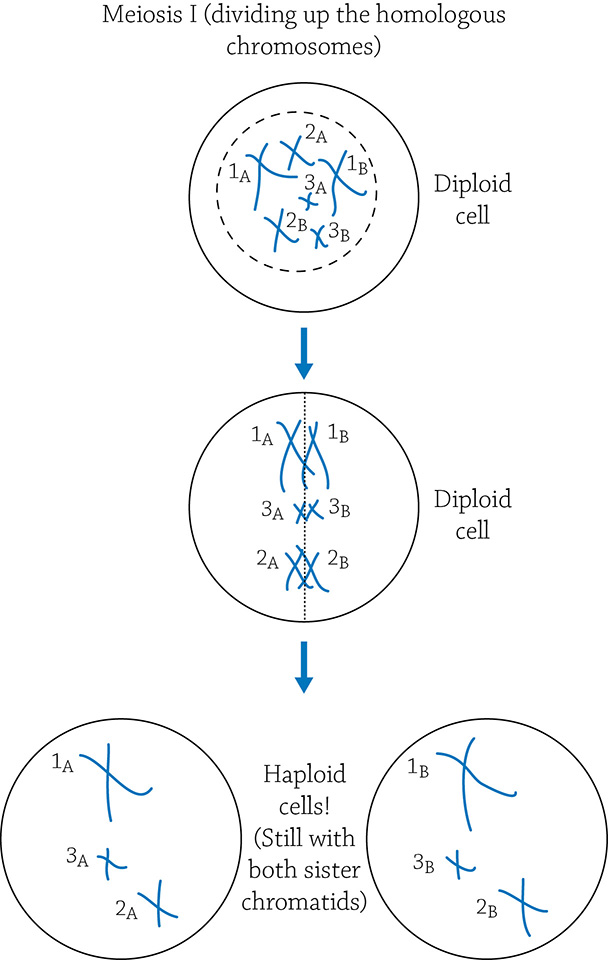
Meiosis I is filled with novel happenings that did not occur in mitosis. For example, the homologous chromosomes seek out their partner and clump together, in a process called synapsis. This is necessary, because when these newly formed tetrads (tetra- = four, as in four total sister chromatids) line up in the middle, the cell needs to make sure one homologous chromosome is on one side of the metaphase plate, and the other homologous chromosome is on the other side of the metaphase plate.
![]()
To simplify things, we are not going through the detail of prophase → metaphase → anaphase → telophase again. Just understand that each of those steps do occur, in both Meiosis I and Meiosis II. For example, when the homologous chromosomes line up in the middle during Meiosis I, it’s called metaphase I; when the sister chromatids line up in the middle during Meiosis II, it’s called metaphase II.
Once each of the homologous chromosomes go their separate ways (and end up in separate cells), each cell will have only ONE of each chromosome 1, 2, 3 … and so on. That means after meiosis I, the two resulting cells are haploid cells containing only a single set of chromosomes. Yes, each chromosome still has a sister chromatid attached to it, but that doesn’t matter in the definition of haploid (one set of chromosomes) versus diploid (two sets of chromosomes). The cell does, however, need to undergo a second round of cell division in order to separate those two sister chromatids into separate cells. This happens in meiosis II.
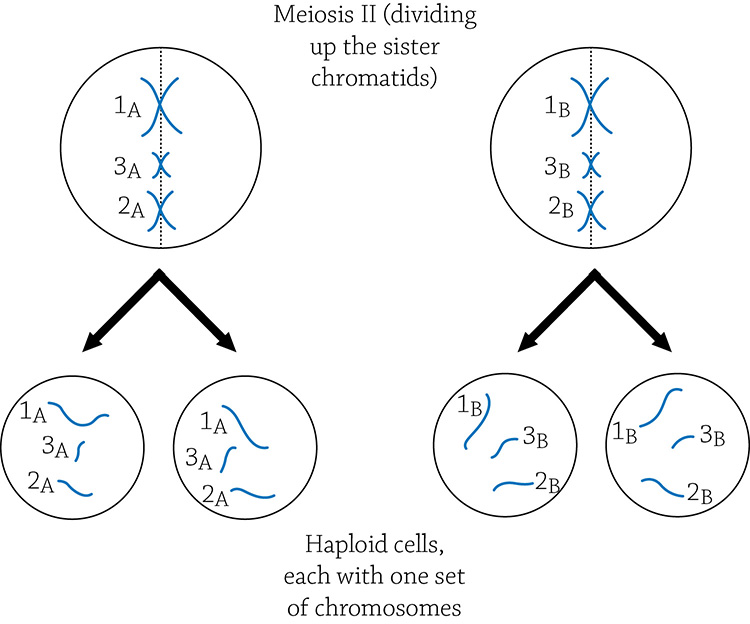
It’s important to note that DNA replication did NOT occur again before this second division! If it had, we would end up with too much DNA in the cell. Remember, the point of meiotic division is to cut the chromosome number in half, and undergoing two rounds of cell division (with only one pass through the S phase) accomplishes just that!
Meiosis Shuffles the Two Sets of Chromosomes Like a Deck of Cards
Now we know that mitosis produces diploid cells that are exactly like the parent cell, and meiosis produces haploid cells that are different from the parent cell. This ability of meiosis to produce genetically different cells is very significant, and our must know concept. In the process of evolution, it is these differences among individuals of the same species that provide the reservoir by which new traits are selected for as “most fit” and passed on to the next generation.
![]()
Evolution of a species is based on there being variation in a population. In order for evolution to occur, some members of the population are a bit better at survival, simply because they were born with traits different from their not-as-successful brethren. The differences in members of a species allows natural selection to occur, because some traits are “selected” as being more fit in the struggle for survival. These differences in members of a species are in large part due to meiosis’s ability to shuffle things up and create a bunch of new genetic combinations in the gametes.
One of meiosis’s big shuffling steps occurs in Meiosis I, when the cell first splits and separates the homologous chromosomes. The origin of those two sets of chromosomes are from your parents, right? And recall that a pair of homologous chromosomes contain the same genes, but are not genetically identical; it makes a difference, then, which of the homologous pair lines up on which side of the metaphase plate. For example, earlier, when we discussed the steps of Meiosis I, you saw this cell:
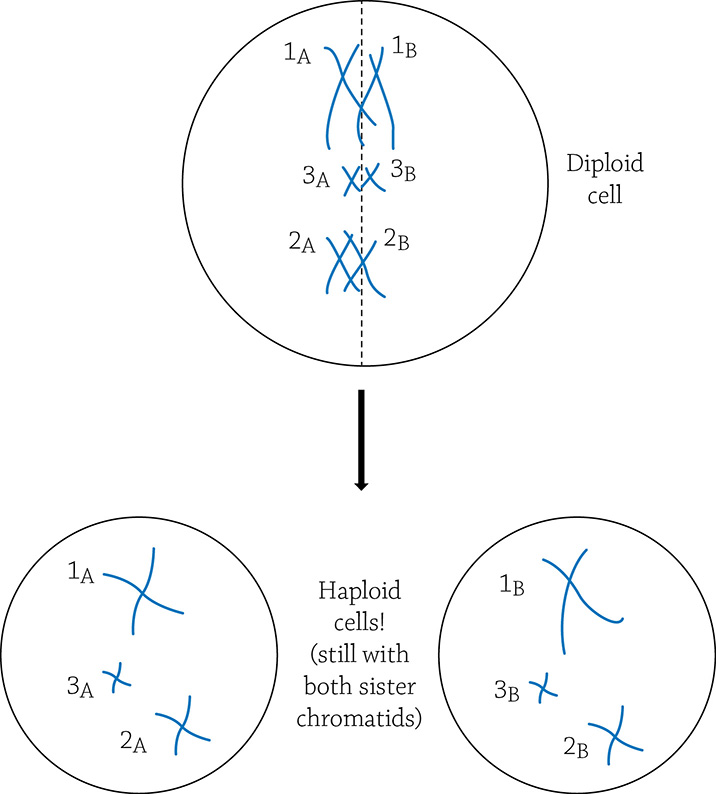
In this scenario, after Meiosis I, the resulting daughter cells contain one set of chromosomes (1, 2, and 3) and they each came from the same “source” … chromosomes 1A, 2A, and 3A were from your mom, and 1B, 2B, and 3B were from your dad. After Meiosis II (when those sister chromatids are separated), the resulting gamete (whether egg or sperm) would also contain chromosomes entirely from maternal or paternal origin. But is there another way this could have played out? Instead of all of your maternal chromosomes lining up on the left side of the metaphase plate, only 1A and 2A are on the left; chromosome 3 lined up differently, with the father’s copy on the left.
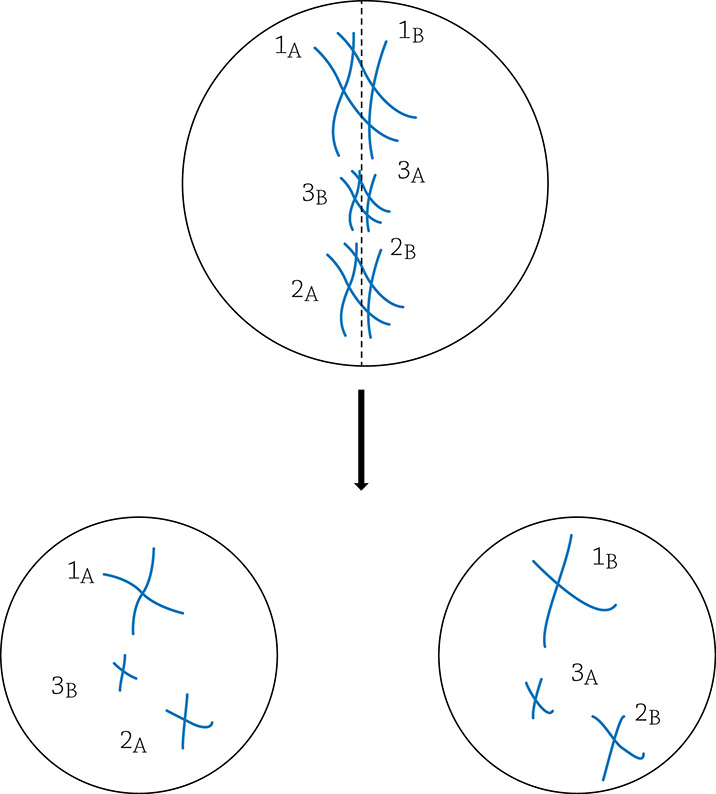
Notice that just because of random alignment of homologous chromosomes, the resulting cells will now have a combination of chromosomes, this time from both sources (your mom’s and your dad’s DNA).
This random alignment of the homologous chromosomes along the metaphase plate is referred to independent assortment. It’s “independent” because chromosome 1A doesn’t really care which side 2A chooses … it’s gonna do its own thing.
![]()
This is when my students get really confused. I keep talking about making cells using DNA from either the mother or the father. Take a moment to focus again on what we’re actually doing: we are talking about how you, in your body, create your own gametes (whether egg or sperm). This is happening only in the testes and ovaries, and you are creating haploid cells based on your own selection of chromosomes … which were provided to you by your mom and dad. So, when we talk about how your own body creates a ton of different combinations of egg or sperm, we have to think back to where you received your own two sets of chromosomes (your parents). Every generation is simply creating the next generation out of the genetic material passed down from our ancestors.
In this example, we’re using a simple cell with 2n = 6, or n = 3. If you want to figure out how many different combinations are possible with this independent assortment concept, you use the equation 2n, where n = haploid chromosome number. Therefore, there are 23 = 8 different combinations of gametes possible. Now … how many combinations are possible in YOUR BODY? We have a haploid number of n = 23, so the number of different gametes you can make on your own is 223, or a little over 8 million combinations! What an impressive selection! But guess what … the variations don’t stop there. There is a sneaky little bit of shuffling that occurs on a smaller scale, when synapsis occurs and those homologous chromosomes pair up. A phenomenon called crossing over occurs, when the homologous chromosomes will swap matching segments with each other (thus swapping the same genes). This increases variation because if you inherit chromosome #3 from your dad, it may actually carry a little bit of your mom’s chromosome #3, because crossing over occurred.
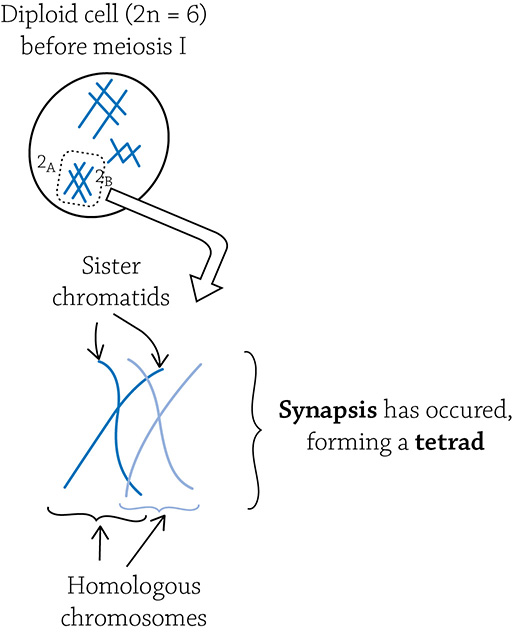
Synapsis between homologous chromosomes 2A and 2B
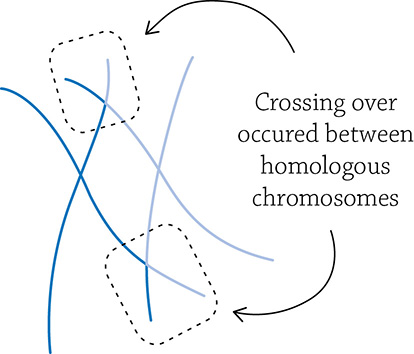
Crossing over occurring between homologous chromosomes 2A and 2B
Both of these events—independent assortment of homologous chromosomes during metaphase I and crossing over—are key steps in the must know concept of creating a vast array of different genetic combinations in the resulting gametes.
REVIEW QUESTIONS
1. Choose the correct term from each pair: Meiosis creates cells with half/equal/double the DNA of the parent cell. Specifically, each gamete contains only one set/two sets of chromosomes.
2. True or False: Any cell in your body can undergo meiosis.
3. Choose the correct term from each pair: The specialized cells in the ovaries and testes that produce the gametes start off as haploid/diploid cells. Once they divide by meiosis/mitosis, they produce the haploid/diploid gametes (egg or sperm). When an egg and sperm fuse in sexual reproduction, it creates a haploid/diploid zygote cell.
4. What would be the result of crossing over between sister chromatids during meiosis I?
5. Why is it important that meiosis creates gametes that are not genetically identical to one another?
6. Choose the correct term from each pair: The cell that divides by meiosis to create the gametes is haploid/diploid because it contains one set/two sets of chromosomes (referred to as a haploid/diploid cell). The resulting gametes (either egg or sperm) contain one set/two sets of chromosomes and are called haploid/diploid cells.
7. What three events occurred in meiosis, but did not occur in mitosis?
8. At what stage of meiosis does the diploid cell become a haploid cell?
9. Meiosis creates gametes with different genetic combinations through the process of ___________________ (when segments of two homologous chromosomes swap with one another) and ___________________ (the homologous chromosomes line up in a different pattern during metaphase I).
